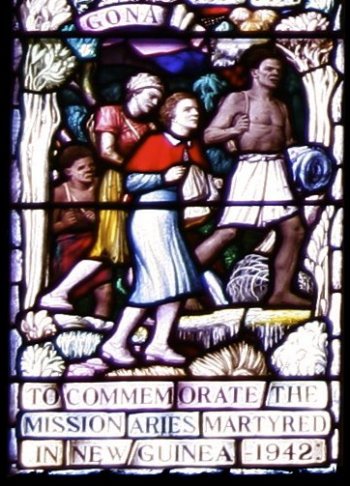
The bottom panel of the left light represents two female missionaries fleeing through the jungle before the Japanese. They are accompanied by two Papuans. The inscription at the top names the village of Gona, so this panel is often thought of as representing the two Gona sisters, May Hayman and Mavis Parkinson, even though the prominent Papuan figure, taken to represent Lucian Tapiedi, attended on the Sangara missionaries rather than those from Gona. The final figure in the panel is taken to represent the other Papuan martyr, Leslie Gariadi, even though he was based at Moresby and killed at sea. The representations of the martyrs in the window are clearly to be taken as symbolic rather than as historical portrayals of the events.
This lower panel, with its inscription "To Commemorate the Missionaries Martyred in New Guinea – 1942:" is the first element of Maynard's third theme, that of Goodness— revealed in this case by the faithfulness and sacrifice of the missionaries and their attendants in the face of danger. Bishop Strong, in his commentary, sees the bottom three panels as representing the martyrs themselves, and as being rather outside Maynard's themes of Beauty, Truth and Goodness; or, perhaps, as encompassing all three, rather than just one, of these.
Another aspect of the four panels that make up the left light of the window is that the central figures in each tableau are female: this left window is clearly dedicated to the work, through beauty, truth and goodness, of the missionary women in New Guinea.